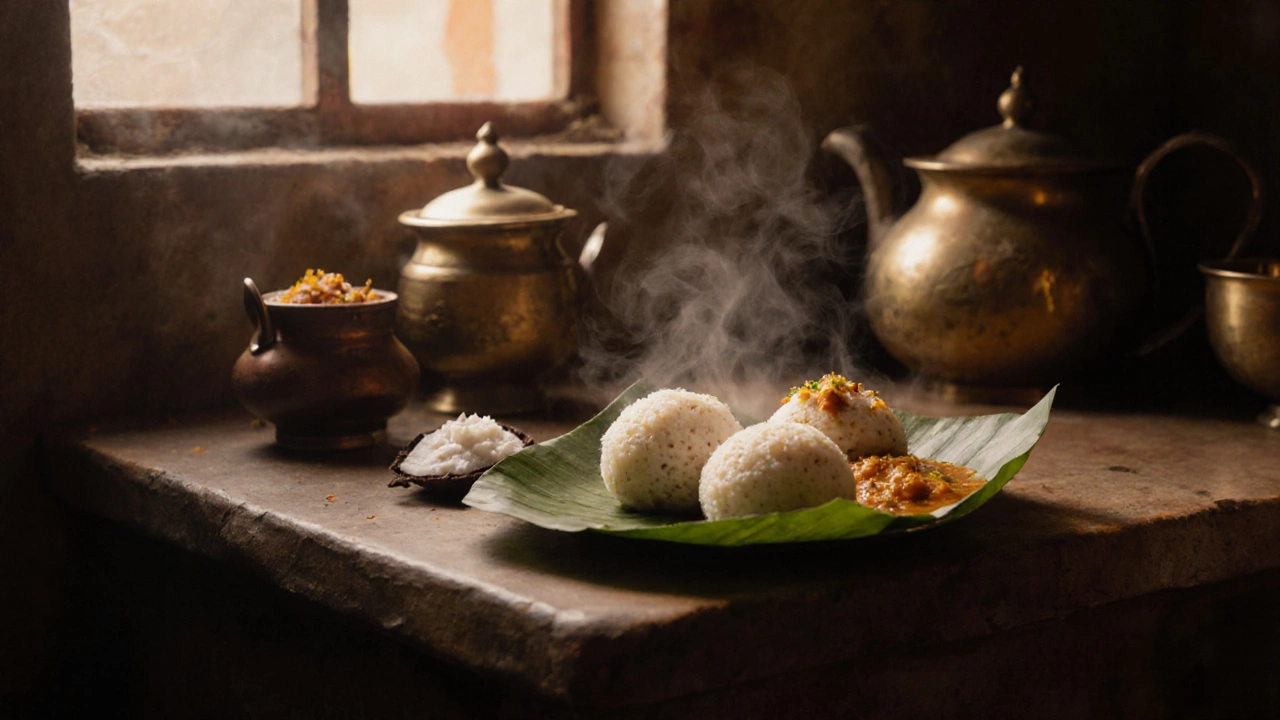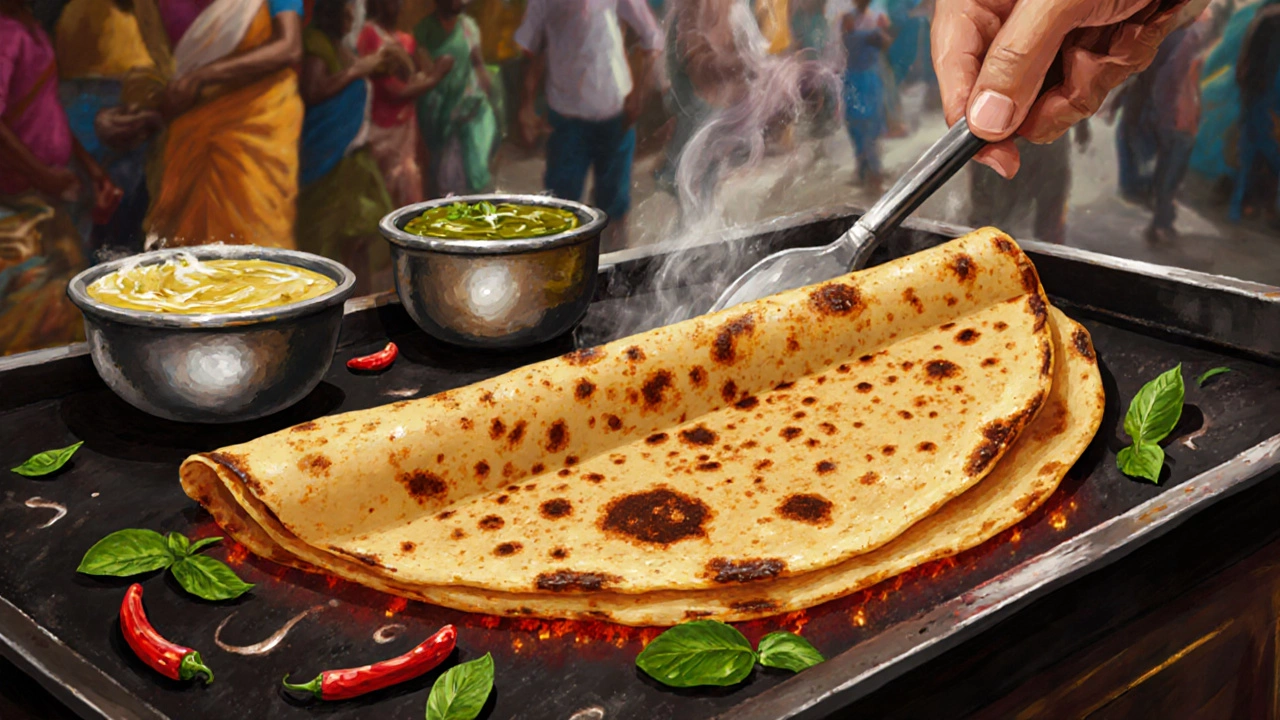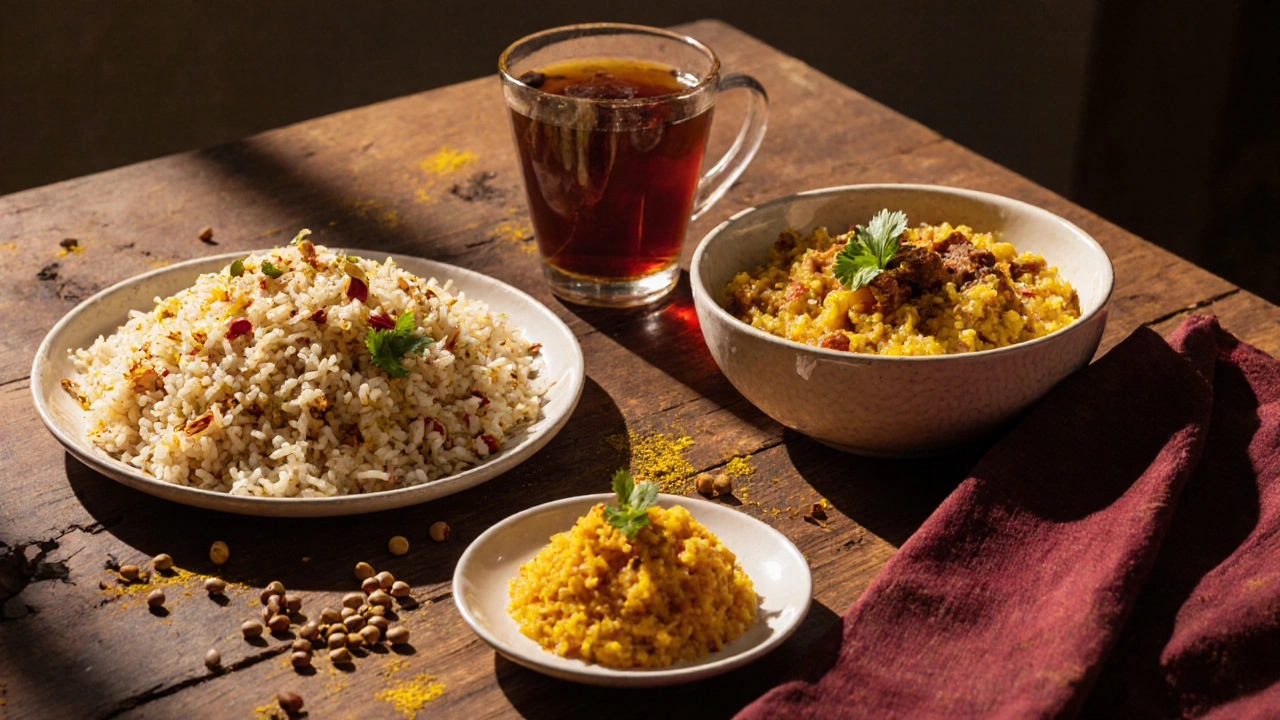What Can I Eat for Breakfast in India? 15 Authentic Quick Breakfast Ideas
15 November 2025

Indian Breakfast Finder
Breakfast Options Comparison
| Name | Region | Time | Dietary | Health |
|---|---|---|---|---|
| Idli with Sambar | South India | 20 min | Vegan | High fiber |
| Dosa | South India | 15 min | Vegan | Probiotic |
| Poha | Western India | 10 min | Vegan | Low glycemic |
| Upma | South India | 15 min | Vegan | High protein |
| Paratha | North India | 25 min | Vegetarian | Fiber-rich |
| Chai and Pakora | National | 15 min | Vegetarian | Protein-rich |
| Khichdi | National | 15 min | Vegan | Gut-friendly |
| Appam with Stew | Kerala | 25 min | Vegetarian | Probiotic |
Ever woken up craving something warm, spicy, and totally different from toast and cereal? In India, breakfast isn’t just a meal-it’s a daily ritual shaped by region, season, and tradition. You don’t need hours to make it, either. Most Indian breakfasts take less than 20 minutes and use ingredients you likely already have in your pantry. Whether you’re in Mumbai, Chennai, or Auckland, you can bring a taste of India to your table without a single trip to the grocery store.
Idli and Sambar: The South’s Quiet Hero
Idli-soft, steamed rice cakes-are the most common breakfast in South India. Made from fermented rice and urad dal batter, they’re light, digestible, and packed with probiotics. Serve them with sambar, a tangy lentil stew thickened with tamarind and spices like mustard seeds, curry leaves, and dried red chilies. A dollop of coconut chutney on the side? That’s the full package. You can buy ready-made idli mix in most international supermarkets, or make your own batter the night before and steam it in the morning. It’s the ultimate grab-and-go breakfast: no frying, no oil, no guilt.
Dosa: The Crispy Canvas
If idli is the quiet hero, dosa is the showstopper. A thin, crispy fermented crepe made from the same batter as idli, dosa is often filled with spiced potatoes (masala dosa) or served plain with chutneys. The key is the batter’s fermentation-let it sit overnight at room temperature, and you’ll get that signature crisp edge and airy center. Cook it on a hot griddle with a little oil, flip once, and you’ve got breakfast ready in five minutes. Street vendors in Bangalore sell them for under 30 rupees. At home, you can make them vegan, gluten-free, and endlessly customizable.
Poha: Flattened Rice Magic
Head to Maharashtra or Gujarat in the morning, and you’ll smell turmeric and mustard seeds frying in oil. That’s poha-the humble flattened rice dish that turns simple ingredients into something deeply satisfying. Rinse 1 cup of poha, drain, then sauté with onions, green chilies, curry leaves, peanuts, and a pinch of turmeric. Add lemon juice at the end. Done in 10 minutes. It’s light enough for a hot day, warm enough for winter, and holds up well if you make it ahead. Poha is the Indian version of oatmeal-but way more flavorful.
Upma: The Savory Porridge
Upma is what happens when semolina meets Indian spices. Roast semolina (rava) in ghee or oil until golden, then add water, turmeric, mustard seeds, urad dal, curry leaves, and chopped vegetables. Stir until thick and fluffy. It’s comforting, filling, and endlessly adaptable. Add peas, carrots, or even chopped spinach. Some versions use broken rice or oats instead of semolina. You can make it in under 15 minutes and it’s naturally gluten-free if you use certified rava. It’s the breakfast that doesn’t ask for much but gives you everything.
Paratha with Pickle and Yogurt
North India wakes up to paratha-flaky, layered flatbreads stuffed with potatoes, cauliflower, paneer, or even minced meat. Make the dough the night before, roll it out in the morning, and cook it on a tawa with a little ghee. Serve with a side of plain yogurt, a spoonful of mango pickle, and a cup of chai. The contrast of warm bread, cool yogurt, and spicy pickle is addictive. You don’t need fancy tools-just a skillet and patience. Store-bought frozen parathas work in a pinch, but homemade ones taste like Sunday morning.
Chai and Pakora: The Quick Fix
Not everyone has time to cook. That’s where chai and pakora come in. Boil water with tea leaves, ginger, cardamom, and milk. While it simmers, fry a handful of besan (chickpea flour) batter with sliced onions, spinach, or potatoes. It’s not a full meal, but it’s the kind of breakfast that feels like a hug. Pakora is fried, yes-but it’s also protein-rich and satisfying. Eat it with a cup of masala chai, and you’ve got energy for hours. This combo is what millions of office workers in Delhi and Kolkata start their day with.

Poori and Aloo Sabzi: The Weekend Treat
Poori are deep-fried breads that puff up like balloons. They’re not daily fare, but on weekends or holidays, families make them fresh. Serve with a simple potato curry-potatoes boiled, mashed lightly, and sautéed with cumin, turmeric, and a touch of chili. The contrast between the airy, crispy poori and the soft, spiced potatoes is perfect. It’s messy, indulgent, and worth every calorie. If you’re short on time, use store-bought poori and heat them in the oven. The sabzi still makes it feel homemade.
Medu Vada: The Lentil Donut
These savory lentil fritters look like doughnuts, but taste like a spice-packed protein bomb. Made from soaked urad dal ground into a smooth paste, shaped into rings, and fried until golden, medu vada is crispy outside and soft inside. Eat them with coconut chutney or sambar. They’re high in protein, naturally gluten-free, and take less than 25 minutes to make. In Tamil Nadu, they’re sold at every street corner before 8 a.m. You can even bake them for a lighter version-just skip the oil.
Missal Pav: Mumbai’s Bold Breakfast
This is not for the faint of heart. Missal is a spicy curry made from sprouted moth beans, tossed with onions, tomatoes, and a fiery red chile paste. It’s topped with farsan (crunchy savory snacks), chopped coriander, and lemon. Served with pav-soft, buttered bread rolls-it’s a messy, vibrant explosion of flavor. You’ll find it in Mumbai’s bustling breakfast stalls. At home, use canned sprouted beans and a ready-made missal masala powder. It’s bold, tangy, and exactly what you need when you’re feeling sluggish.
Daliya: The Ancient Grain Breakfast
Daliya is cracked wheat cooked like porridge. It’s been eaten in rural India for centuries because it’s cheap, filling, and keeps you full for hours. Simmer it with milk or water, add a little jaggery or sugar, and top with nuts and dried fruit. For a savory version, cook it with vegetables and turmeric. It’s the Indian equivalent of steel-cut oats-but with more character. Daliya is high in fiber, low glycemic, and perfect for anyone managing blood sugar. It’s not flashy, but it’s the breakfast that keeps you going.
Khichdi: The One-Pot Reset
When you’re sick, tired, or just over everything, Indians turn to khichdi. It’s a simple mix of rice and moong dal, cooked with turmeric, cumin, and ghee. Some add vegetables, others keep it plain. It’s soothing, easy to digest, and nourishing. Cook it in a pressure cooker for 15 minutes. Serve with a side of yogurt or pickle. It’s the ultimate comfort food-and yes, it’s eaten for breakfast too. In Ayurveda, it’s called the perfect reset meal. No wonder it’s the go-to after a late night or a long travel day.

Appam with Stew: Kerala’s Sweet-Savory Start
Appam are delicate, lacy rice pancakes with a soft center and crispy edges. Made from fermented coconut milk and rice batter, they’re steamed in special pans. Serve with a mild vegetable or chicken stew-coconut milk-based, lightly spiced with cardamom and cinnamon. It’s sweet, savory, and warm. The texture is unlike anything else: chewy, tender, and airy. You can buy appam mix online, or make the batter the night before. It’s a breakfast that feels like a vacation.
Poha Pattice: The Crispy Twist
Take leftover poha, mix it with mashed potatoes, green chilies, and spices, shape into patties, and shallow fry. That’s poha pattice-a crunchy, savory snack that doubles as breakfast. It’s popular in Maharashtra and Gujarat, often sold by street vendors. It’s a clever way to use leftovers, and it’s surprisingly satisfying. Serve with mint chutney or a cup of hot tea. It’s breakfast as comfort food, reimagined.
Chole Bhature: The Weekend Indulgence
Chole (spicy chickpea curry) and bhature (deep-fried leavened bread) are a power breakfast in North India. The chickpeas are slow-cooked with tomatoes, garlic, and a blend of spices like amchur and garam masala. The bhature is made with maida (refined flour), yogurt, and baking powder, then fried until golden. It’s heavy, rich, and unforgettable. You don’t eat this every day-but when you do, it’s an event. Make the chole ahead, fry the bhature fresh. Pair with sliced onions and lemon. It’s the kind of breakfast that makes you forget you’re trying to eat healthy.
Onion Bhaji with Tea: The No-Fuss Option
When you’ve got 10 minutes and zero motivation, onion bhaji saves the day. Mix grated onions into chickpea flour with a pinch of salt, chili powder, and cumin. Drop spoonfuls into hot oil. Fry until golden. Eat with a cup of chai. That’s it. No chopping, no complex steps. It’s protein-rich, crunchy, and deeply satisfying. This is the breakfast of students, shift workers, and anyone who just needs something real to start the day.
Why Indian Breakfasts Work So Well
Indian breakfasts aren’t just about taste-they’re designed for energy, digestion, and balance. Fermented foods like idli and dosa boost gut health. Lentils and legumes provide steady protein. Spices like turmeric and cumin aid digestion. Most meals are low in sugar and high in fiber. Even the fried options-like vada or bhaji-are made with minimal oil and eaten in moderation. There’s no cereal here, no sugary yogurt. Instead, you get food that fuels without crashing.
How to Start Your Own Indian Breakfast Routine
- Start with one dish-try poha or upma. They’re quick and use common ingredients.
- Buy fermented batter mixes online if you don’t want to soak and grind dal.
- Keep spices like mustard seeds, curry leaves, turmeric, and cumin on hand-they’re the backbone of most breakfasts.
- Make batter or chutney in bulk and freeze it.
- Pair your breakfast with chai. It’s not optional-it’s part of the experience.
You don’t need to recreate an entire South Indian meal. Just one bowl of poha or one dosa with chutney can transform your morning. It’s not about authenticity-it’s about flavor, energy, and joy.
What is the most popular breakfast in India?
Idli and dosa are the most widely eaten breakfasts across South India, especially in states like Tamil Nadu, Karnataka, and Kerala. In the north, paratha and poha are more common. But overall, idli with sambar and chutney is the most consistent choice nationwide, eaten by millions every day.
Can I make Indian breakfasts without a pressure cooker?
Yes, absolutely. You can steam idlis in a regular pot with a steamer basket. Cook upma and poha on the stovetop. Fry vada or bhaji in a skillet. Most Indian breakfasts don’t need special equipment-just a stove, a pan, and a little patience. Pressure cookers speed things up, but they’re not required.
Are Indian breakfasts healthy?
Most traditional Indian breakfasts are naturally healthy. They’re high in fiber from lentils and whole grains, low in added sugar, and use spices with anti-inflammatory properties. Fermented foods like idli and dosa support gut health. Even fried items like vada are made with chickpea flour, which is protein-rich. The key is portion control and avoiding excess oil or sugar.
Where can I find Indian breakfast ingredients outside India?
Most major supermarkets now carry items like urad dal, rice flour, poha, and curry leaves in the international aisle. Indian grocery stores are the best bet-they stock everything from fermented batter mixes to ready-made chutneys. Online retailers like Amazon, iHerb, or ethnic food sites also deliver spices and grains worldwide. Don’t overlook frozen options-many stores sell frozen idlis and dosas.
How do I make dosa batter ferment faster?
In cooler climates, place the batter in a warm spot-near a heater, in an oven with the light on, or wrapped in a towel near a sunny window. Add a pinch of fenugreek seeds to the batter before soaking-they help fermentation. The batter should double in volume and smell slightly sour. This usually takes 8-12 hours in warm weather, up to 18 hours in cold.